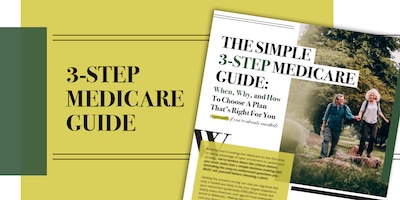
Which Medicare Plan Is Right For You?
Whether you’re looking into Medicare for the first time or taking advantage of open enrollment to update your strategy, this article is for you. Choosing the wrong plan can cost you big-time! Not only is healthcare likely to be the largest expense in your retirement (potentially $285,000 or more), but nearly every American over age 65 must eventually enroll in Medicare1. Making the wrong choices could cost you thousands in permanent penalties, leave you facing high medical bills without coverage, or force you into a too-expensive plan. Don’t worry, I’ll walk you through the options so that you can feel comfortable about your decision.
The Options
Choosing a Medicare plan means balancing priorities and knowing what’s most important to you. Remember — each person has to choose what’s best for them. Just because your friend Karen is on Medicare Advantage doesn’t mean you need to be too. Also, remember that if you feel overwhelmed at any point, just pick up the phone and call our office. We’d be glad to help you understand your options and help you make the best decision.
Option 1: Original Medicare (Parts A & B)
Original Medicare is made up of two parts. Part A covers hospitals, rehab, and hospice care, while Part B covers doctor visits, lab tests, screenings, and other outpatient services. While Part A is free for most people, you will likely have to pay monthly premiums for Part B plus any deductibles, copays, and coinsurance.
Pros: You have the freedom to visit any provider or hospital in the U.S. that participates in Medicare and you don’t need to work with a primary care physician to see specialists. This flexibility is ideal if you travel outside of your home network or have existing relationships with doctors you want to keep.
Cons: Services have deductibles and copays, which may require you to purchase a Medigap or Medicare Supplement Plan (these two names are the same thing) to control your out-of-pocket spending. You will also need to purchase prescription drug coverage (Medicare Part D) separately.
Long Story Short. Does This Sound Like You?
- I already have doctors and specialists, and don’t want to switch…
- I travel away from home and want coverage that spans the entire United States…
- I value the freedom to visit almost any doctor, hospital, and medical provider that accepts Medicare…
Option 2: Medicare Advantage Plan (Part C)
Medicare Advantage Plans are offered through private insurers (think Blue Cross Blue Shield). Often referred to as Part C, this plan is typically structured like an HMO or PPO and provides comprehensive health coverage combining Parts A and B.
Pros: Many Part C plans cover extra services like vision, hearing, and dental and may include prescription drug coverage. Also, these plans typically have an annual limit on your total out-of-pocket costs.
Cons: In addition to paying a Part B premium, you’ll typically pay an extra monthly premium for the Medicare Advantage plan. Networks change, doctors can leave, and benefits can change over time.
Long Story Short. Does This Sound Like You?
- I don’t mind going through a primary care physician to see specialists…
- I stay close to home and can find a doctor within my network…
- I value simplicity and don’t want to manage multiple insurance plans…
Okay, Now Let’s Talk About Drugs….. Prescription Drugs
Medicare Part D helps you cover the cost of your prescription drugs. You’ll need to sign up for this plan as soon as you become eligible for Medicare, even if you don’t use prescription drugs, to avoid paying late enrollment penalties.
Some Medicare Advantage Plans cover prescription drugs but be sure to double check.
If you opted for Original Medicare you will have to add Part D.
Pros: Copays and other plan details vary by state and insurer, but they will cover most of the cost of your prescriptions.
Cons: After exceeding coverage limits, you’ll pay the full cost of your medications until a Medicare threshold is reached. This “donut hole” gap closes in 2020.
What About Supplemental Insurance? (Medigap)
Supplemental Insurance or more commonly referred to as “Medigap Insurance”, can be purchased through private insurance companies (again, think Blue Cross Blue Shield). This added insurance is meant to fill the coverage gaps in Parts A and B of Medicare and helps with deductibles, copays, coinsurance, etc.
Pros: It limits your out-of-pocket costs for Original Medicare.
Cons: There are many different types of Medigap plans, all with different details.
Before you buy this added insurance, make sure that you don’t have retiree coverage from the military or previous employer
81% of Original Medicare participants had some type of supplemental coverage 2.
ps. I’ve created a step-by-step flowchart that you can use to walk through your options.

Sources: 1: https://www.cnbc.com/2019/04/02/health-care-costs-for-retirees-climb-to-285000.html
2: https://www.kff.org/medicare/issue-brief/an-overview-of-medicare/
This material is for information purposes only and is not intended as an offer or solicitation with respect to the purchase or sale of any security. The content is developed from sources believed to be providing accurate information; no warranty, expressed or implied, is made regarding accuracy, adequacy, completeness, legality, reliability, or usefulness of any information. Consult your financial professional before making any investment decision. For illustrative use only. Opinions expressed are subject to change without notice and are not intended as investment advice or to predict future performance.













